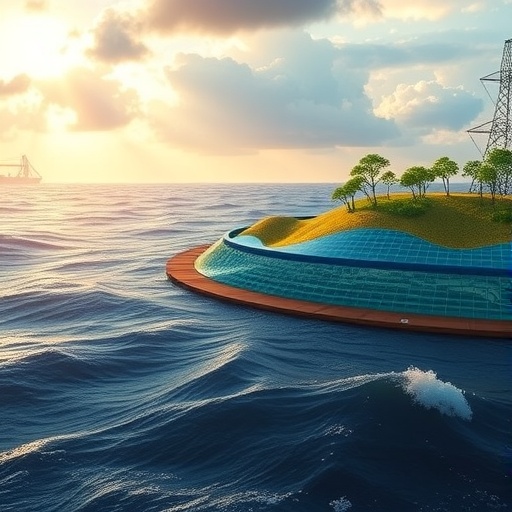In recent years, understanding the balance of life on Earth has become more critical than ever, with photosynthesis at the heart of this inquiry. Photosynthetic organisms serve as the cornerstone of global ecosystems by converting sunlight into organic carbon, a process fundamental to sustaining life on our planet. A groundbreaking study published in Nature Climate Change on August 1, 2025, reveals a complex yet fascinating dynamic: terrestrial plants have driven an overall increase in global net primary production (NPP) since 2003, while marine algae have shown a modest but significant decline. This contrasting trend between land and ocean ecosystems has far-reaching implications for global carbon cycles, climate regulation, and the health of planetary life.
Net primary production, the rate at which photosynthetic organisms accumulate carbon after subtracting their respiratory losses, provides a direct measure of the biosphere’s capacity to fix atmospheric CO₂ into biomass. As such, NPP represents not only the energy foundation for virtually all terrestrial and marine food webs but also a critical component in regulating Earth’s climate. The new research, led by Yulong Zhang and colleagues at Duke University, merges satellite observations with sophisticated computational models to deliver the most comprehensive assessment of global NPP trends spanning nearly two decades.
Previous ecosystem studies often examined terrestrial or marine primary productivity in isolation, leaving a fragmented understanding of their combined influence on global carbon dynamics. Zhang’s team bridges this gap by integrating six satellite-derived datasets, equally representing land and ocean systems from 2003 to 2021. These datasets rely on satellite measurements of chlorophyll concentration — the pigment central to photosynthesis — and fuse this information with environmental variables such as temperature, light intensity, nutrient availability, and ocean mixing depths to estimate NPP with unprecedented accuracy.
.adsslot_YqSlaEDncr{width:728px !important;height:90px !important;}
@media(max-width:1199px){ .adsslot_YqSlaEDncr{width:468px !important;height:60px !important;}
}
@media(max-width:767px){ .adsslot_YqSlaEDncr{width:320px !important;height:50px !important;}
}
ADVERTISEMENT
The findings are striking. Over the 18-year period, terrestrial ecosystems exhibited a considerable increase in NPP, approximately 0.2 billion metric tons of carbon annually. This growth was most pronounced across temperate and boreal regions, where warming temperatures have extended growing seasons and increased vegetation productivity. Factors such as forest expansion, cropland intensification, and localized increases in precipitation also contributed to terrestrial carbon uptake. Interestingly, tropical terrestrial zones, notably in South America, did not share this upward trajectory, suggesting regional heterogeneity in climate impacts on vegetation.
Conversely, the study reveals a decline in marine net primary production at a rate of about 0.1 billion metric tons of carbon per year, predominantly concentrated in tropical and subtropical waters. The Pacific Ocean, in particular, experienced significant reductions in phytoplankton productivity. Rising sea surface temperatures appear to play a pivotal role in this reduction. Warmer surface layers disrupt the vertical mixing of ocean waters, hindering the upwelling of nutrient-rich deeper waters essential for phytoplankton growth. This thermal stratification limits nutrient availability, constraining photosynthetic organisms that form the basis of marine food webs.
Although the net effect is an overall increase in global NPP of roughly 0.1 billion metric tons of carbon annually, the divergent terrestrial and marine trends raise urgent questions about the resilience and future dynamics of Earth’s biosphere. The increase on land partially offsets the marine decline, but the consequences extend well beyond simple carbon accounting. Reduced marine productivity threatens biodiversity hotspots, fisheries sustainability, and the stability of tropical marine ecosystems that support millions of livelihoods.
The research further unveils the sensitivity of ocean primary production to interannual climate variability. Events like El Niño and La Niña exert pronounced effects on marine photosynthesis, shutting down or stimulating phytoplankton growth in ways that far exceed terrestrial responses. The recent sequence of La Niña events after 2015 contributed to a temporary rebound in ocean productivity, highlighting the ocean’s critical role in year-to-year fluctuations in global carbon fixation. This sensitivity emphasizes the need for coordinated monitoring to predict and manage climate-driven ecosystem changes.
From an Earth system perspective, these findings underscore the importance of considering terrestrial and marine ecosystems as interconnected components rather than isolated compartments. Planetary health assessments, climate mitigation strategies, and ecosystem management plans must integrate data across domains to accurately capture the state and trajectory of global carbon cycles. The study’s use of cutting-edge satellite remote sensing and computational modeling exemplifies the potential for technological advances to illuminate complex environmental processes at the planetary scale.
Yet, significant uncertainties remain. The long-term sustainability of terrestrial productivity gains is unclear, particularly in light of changing precipitation patterns, land use pressures, and potential nutrient limitations. Meanwhile, ongoing ocean warming and acidification may exacerbate declines in marine productivity, undermining oceanic carbon sinks and the resilience of global food webs. Addressing these challenges requires sustained, integrated observations and collaborative research across disciplines and institutions worldwide.
Ultimately, this pioneering work reaffirms photosynthesis as the engine of life on Earth and a keystone for understanding and mitigating climate change. By quantifying the opposing trends in terrestrial and marine net primary production, Zhang et al. provide a vital piece of the climate puzzle. Their insights offer a roadmap for scientists, policymakers, and conservationists to track, interpret, and respond to the evolving health of Earth’s biosphere in a rapidly warming world.
Subject of Research: Global Trends in Net Primary Production Across Terrestrial and Marine Ecosystems
Article Title: Contrasting biological production trends over land and ocean
News Publication Date: August 1, 2025
Web References: http://dx.doi.org/10.1038/s41558-025-02375-1
References: Zhang Y., Li W., Sun G., Mao J., Dannenberg M., Xiao J., Li Z., Zhao H., Zhang Q., Hu S., Song C., and Cassar N. (2025). Contrasting biological production trends over land and ocean. Nature Climate Change. DOI: 10.1038/s41558-025-02375-1
Image Credits: Image courtesy of Yulong Zhang, et al., 2025
Keywords: net primary production, photosynthesis, terrestrial ecosystems, marine ecosystems, satellite remote sensing, climate change, carbon cycle, phytoplankton, chlorophyll, Earth system science
Tags: carbon cycle and climate regulationclimate change and biosphere healthDuke University photosynthesis studyglobal photosynthesis trendsimpacts of photosynthesis on ecosystemsimplications of global NPP changesland versus ocean ecosystem dynamicsmarine algae decline effectsnet primary production assessmentorganic carbon accumulation processessatellite observations in ecologyterrestrial plant contributions to NPP





